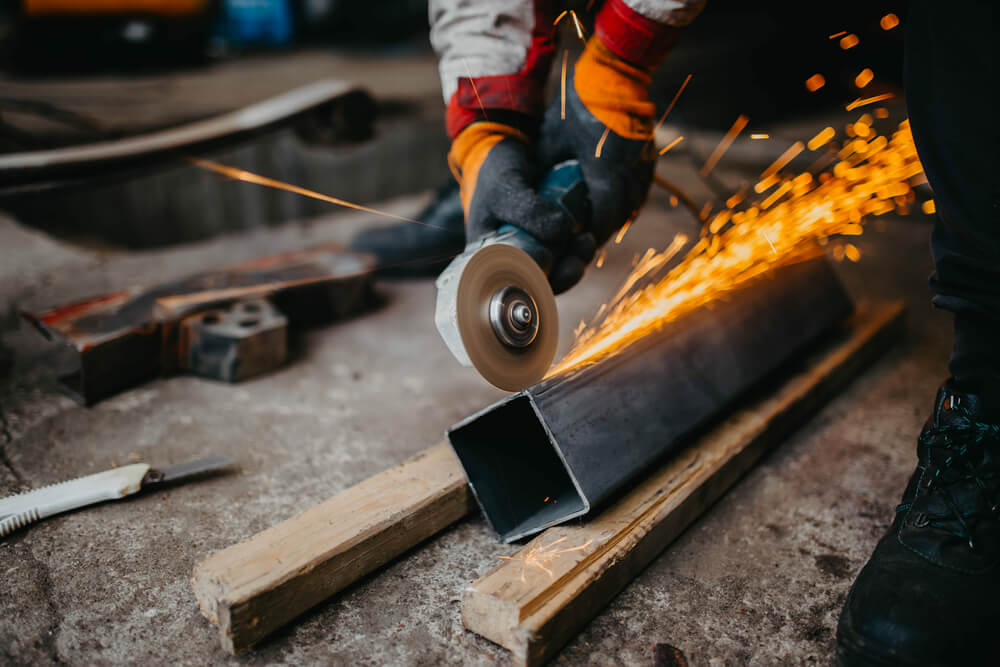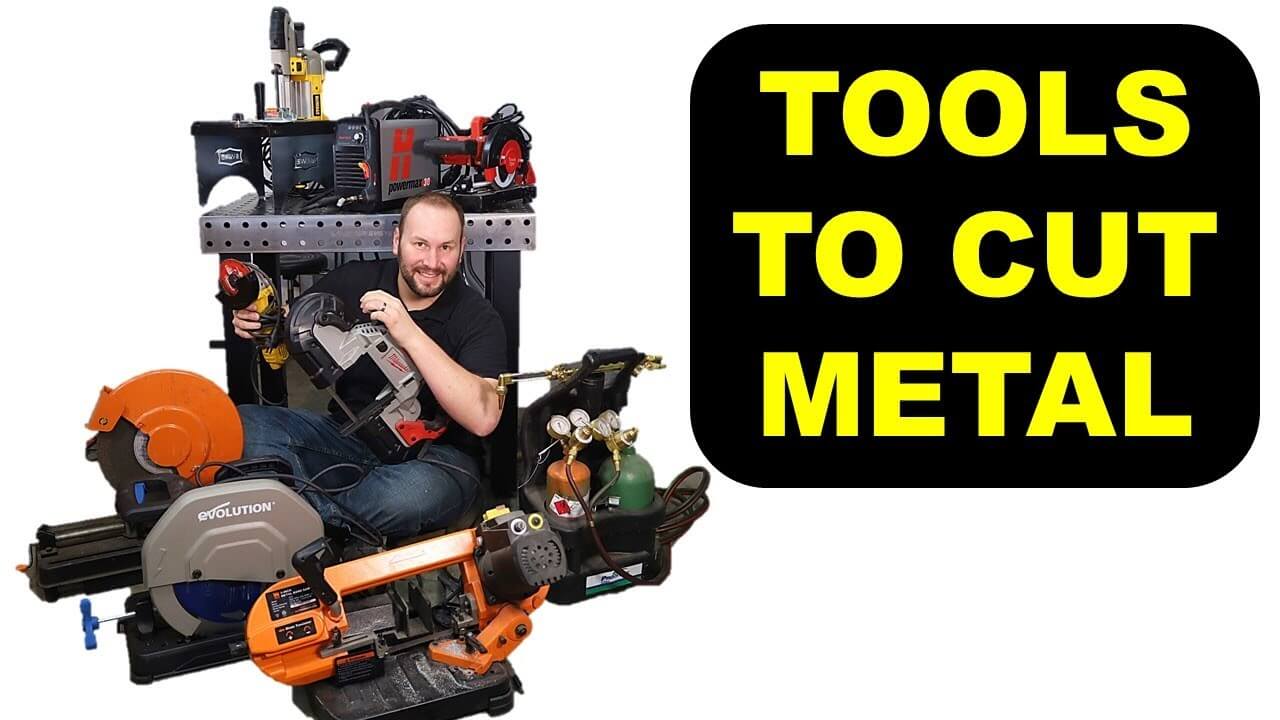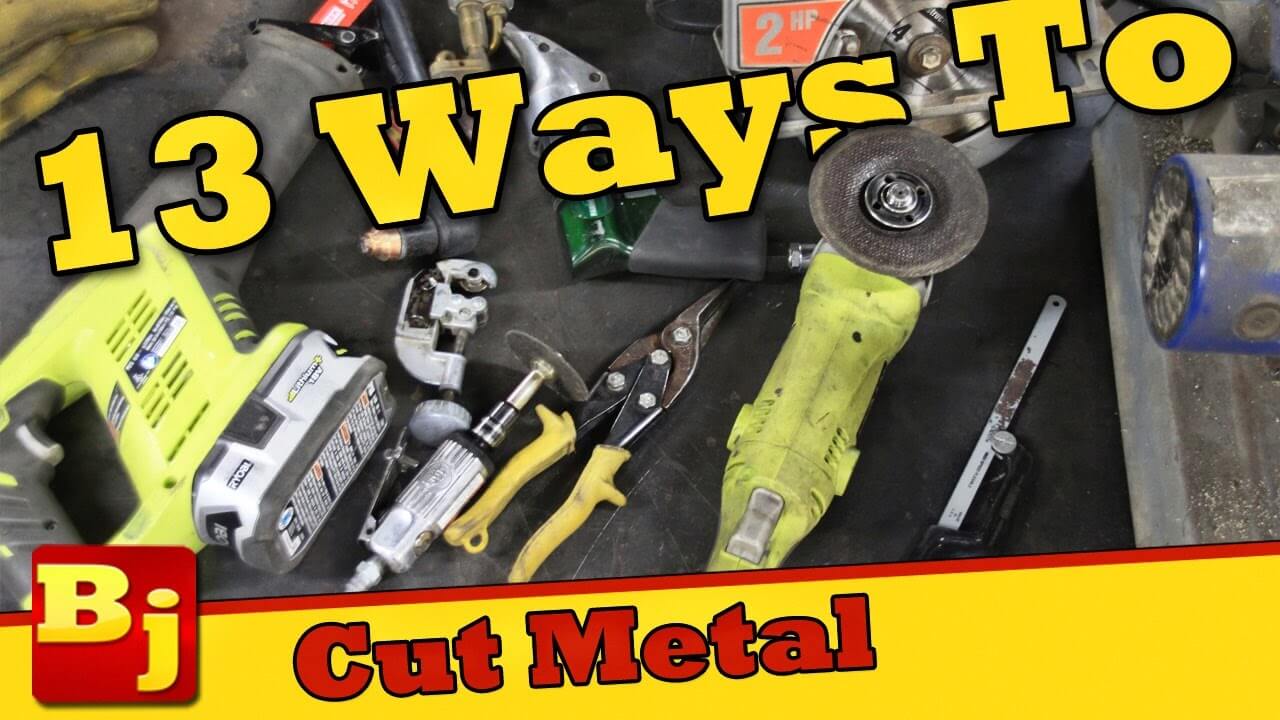What Tool to Use to Cut Metal?
Did you know that, according to a DIY Network survey, over 65% of home DIYers feel unsure about the right tools for metal cutting? I’d like to shed light on this and help you make the perfect choice for your next project.
In a Nutshell:
Selecting the ideal tool for cutting metal hinges on the type of metal and the project’s complexity. For manual cutting, hacksaws, bolt cutters, and tin snips are ideal for basic tasks. For more demanding jobs, power tools like angle grinders, circular saws, and jigsaws offer precision and efficiency. Consider the thickness and durability of the metal, as well as your comfort and experience with these tools. Safety is paramount, so equip yourself with the right tool to ensure a clean and safe cut, whether you’re working on a small home repair or a large construction project.
Equipped with the correct information and tools, you’re not just completing a task; you’re mastering a vital DIY skill and ensuring the success and safety of your projects.
Essential Tools for Cutting Metal: Your Complete Guide
In short, the various hand and power tools, pneumatic cutting tools (powered by compressed air), and gas torches listed below can be used for a range of metal cutting jobs.
Metal Cutting Tools List: Your Guide to Choosing the Right Tool
| Tool | Ideal Use Case | Pros | Cons | Average Price (as of 2024) |
|---|---|---|---|---|
| Hacksaw | Cutting ferrous and non-ferrous metals manually | Affordable, portable, no power required | Labor-intensive, slower, less precise | $15 – $30 |
| Bolt Cutter | Cutting steel rods, rebar, chains, padlocks, wire mesh | Powerful cutting ability, no power required | Not for precise or fine cuts, can be heavy | $20 – $100 |
| Tin Snips | Cutting thin metal sheets like tin and galvanized steel | Precise cuts, affordable, easy to use | Limited to thin materials, manual effort | $10 – $50 |
| Angle Grinder | Versatile cutting of various metals, concrete, ceramics | Highly versatile, portable, fast cutting | Requires different blades for different materials, can be dangerous | $40 – $200 |
| Circular Saw | Straight cuts in wood and metal | Powerful, efficient for straight cuts | Not suitable for intricate cuts, can be expensive | $60 – $300 |
| Reciprocating Saw | Cutting rebar, metal sheeting, and tubing in tight spaces | Versatile, good for hard-to-reach areas | Can be less accurate, requires steady hands | $70 – $200 |
| Chop Saw | Cutting metal pipes and tubing | Precise cuts, powerful, fast | Bulky, not for fine or intricate work | $100 – $400 |
| Jigsaw | Straight, curved, or circular cuts in wood, metal sheeting, and tubing | Versatile, good for intricate shapes | Requires practice for precision, slower than other power tools | $50 – $200 |
| Metal Nibbler | Precise cutting of sheet metals like steel and aluminum | Clean cuts without burrs, precise | Mostly for thin materials, can be costly | $40 – $200 |
| Pneumatic Cutting Tools | Specific metal cutting applications, powered by compressed air | Powerful, precise, used for specialized tasks | Requires air compressor, not as portable | $100 – $500+ |
| Gas Torches | Cutting through thick metals using intense heat | Powerful for thick materials, fast cutting | Requires skill, not for precise cuts, safety risk | $30 – $150 |
Cutting metal without the right tool is like trying to slice bread with a spoon – possible, but why make life harder? A chop saw is your bread knife in the world of metal; precise, efficient, and a cut above the rest!
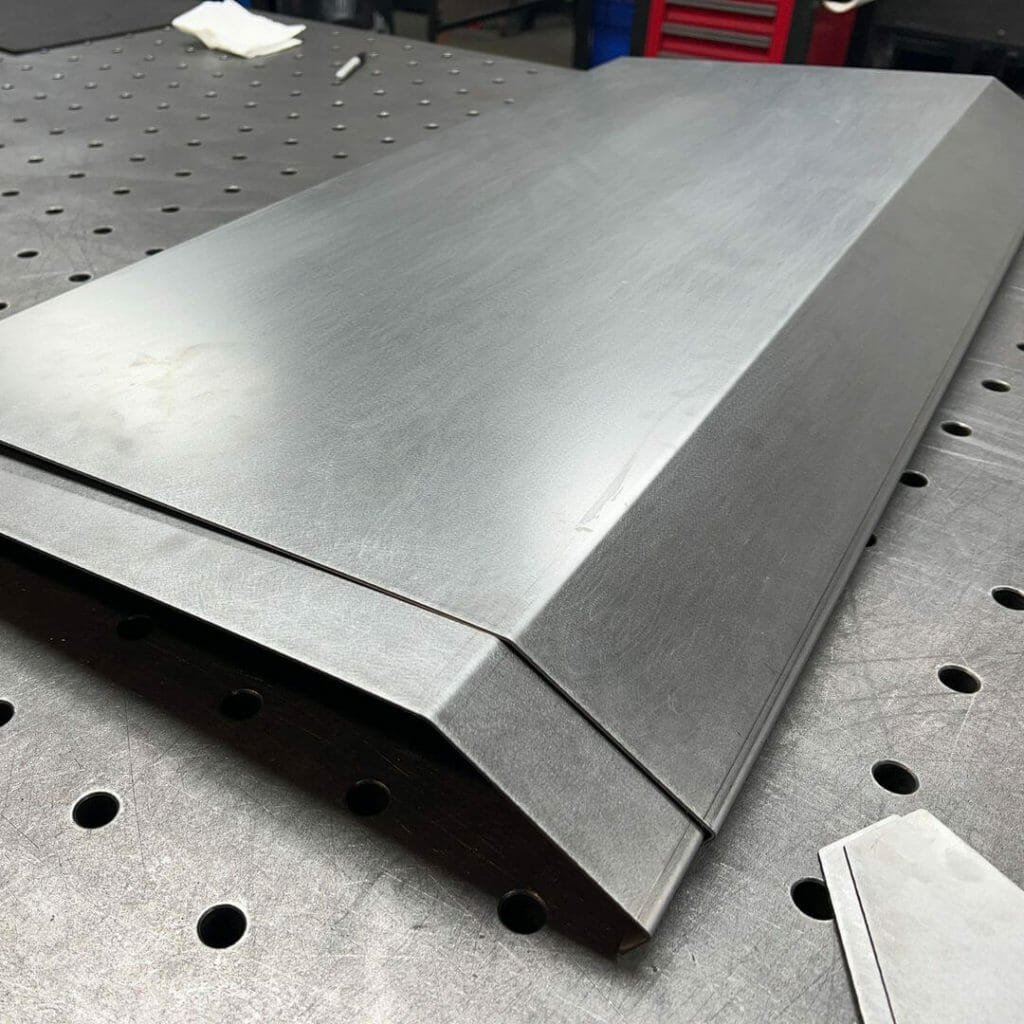
To Cut Sheet Metal
Sheet metals are made in various sizes and thicknesses depending on the sheet’s application.
Not all roofs are the same, so it often happens that a roof sheet has to be sized to a specific length to fit the project.
Sheet Metal Cutting Tools
Metal Nibbler
My go-to tool when cutting sheet metal as a HVAC tech is a double-headed sheet metal nibbler. It is a great tool to use when cutting the following metal materials:
A nibbler is super easy to use. Simply attach it to your cordless drill and it can be driven to a rotation speed between 1500 and 3000 revolutions per minute.
The nibbler attachment is double-headed, meaning it has two cutting heads attached. One serves as a handle mounting when not in use.
Achieving both straight lines and curved cuts is easy with the nibbler. A bonus is that no burrs remain on the cut edge, so no additional filing or grinding is required to finish the cut.
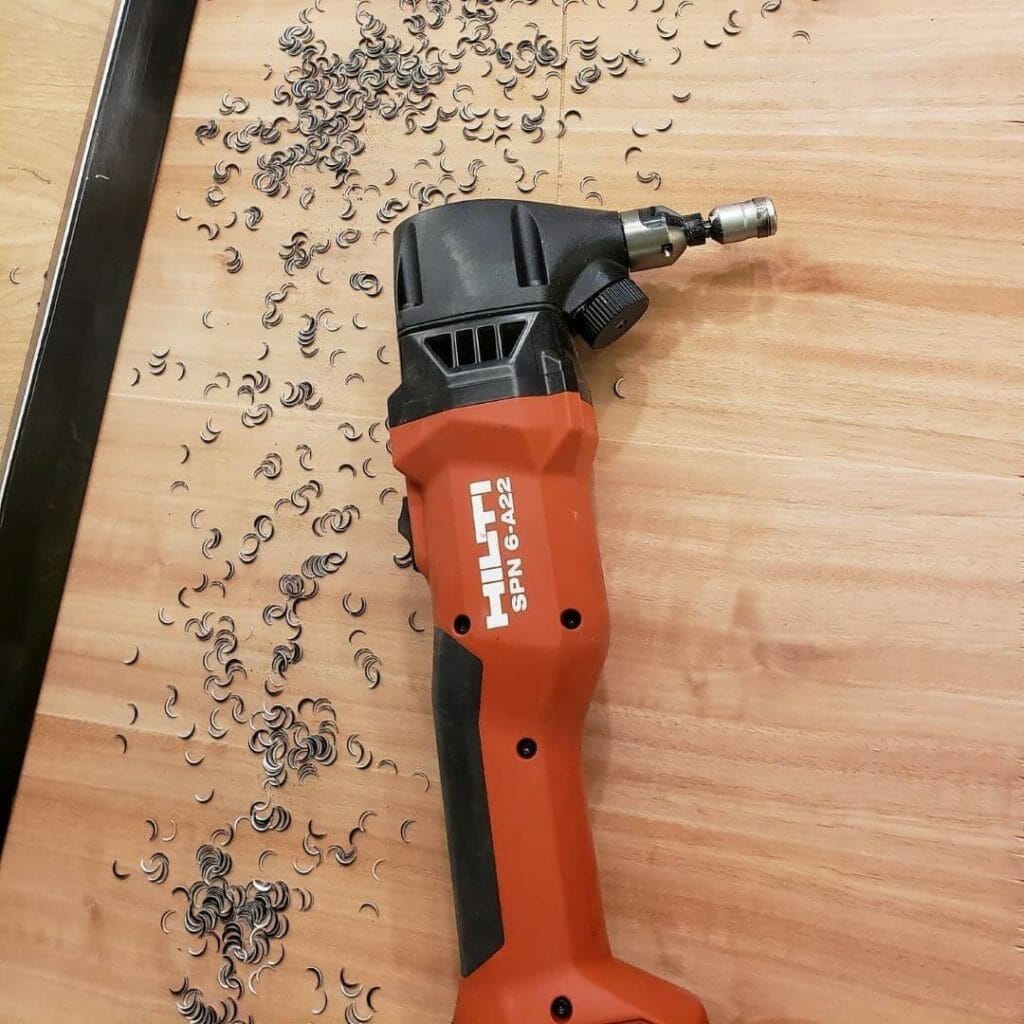
To Cut Metal Pipe
A metal pipe can be challenging to cut when using a handheld metal saw. The pipe’s circular shape means that you’re cutting two metal surfaces simultaneously as the blade passes through the pipe.
Due to its shape, the pipe can be difficult to hold securely and to make angled cuts.
A chop saw is the best power tool for cutting pipe to length. When cutting long pipe lengths, ensure that the pipe is well supported to ensure that the blade of whatever type you’re using doesn’t get pinched by the piece as the cut gets deeper into the material.
Thick Metal Cutting Tools
Chop Saw
A chop saw, renowned for its precision and power, is the go-to tool for cutting various metals including pipes, sheet metal strips, flat bars, rods, and tubing to your desired specifications. Generally, a chop saw comes equipped with an abrasive cutting wheel. However, it demonstrates its full potential when outfitted with specialized metal cutting blades, such as tungsten carbide or diamond-tipped blades.
Take, for instance, the Makita LC1230. This metal cutting saw, featuring a robust 12″ tungsten carbide blade, boasts an impressive maximum cutting depth of 4-1/2″. The saw’s design is particularly user-friendly, featuring a drop-down mechanism. This allows you to securely clamp the metal within its built-in vice. The blade, equipped with a safety shield that retracts upon lowering, is then manually brought down onto the metal, ensuring precise and safe cuts.
Note, that while you can cut metal with a miter saw fitted with a non-ferrous metal cutting saw blade, this setup is more suited for softer metals and may not offer the same level of efficiency and precision for tougher or thicker materials. In such cases, the chop saw, with its specialized capabilities and design, emerges as the superior alternative, especially for more demanding metal cutting projects.
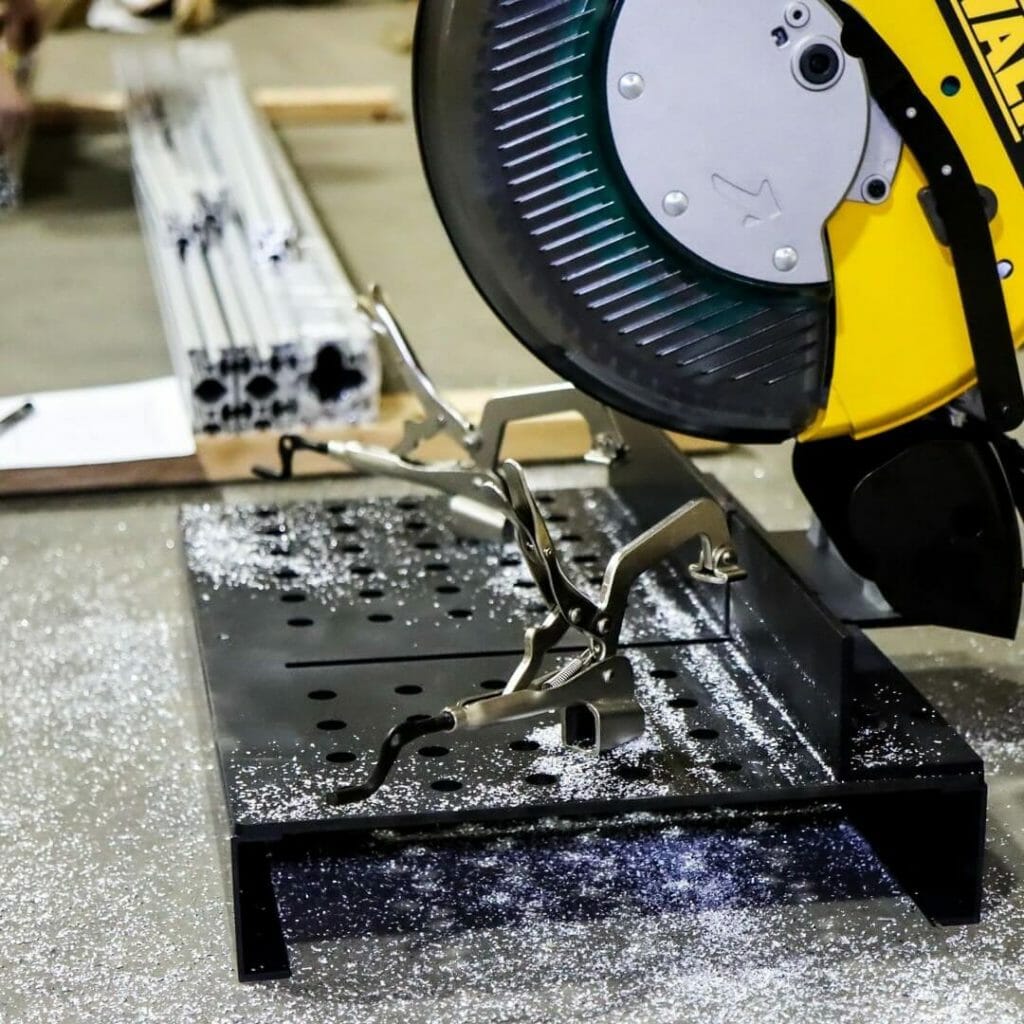
To Cut Stainless Steel
Stainless steel is well known for its resistance to corrosion due to its high chromium and tin content. These materials combine to form a significantly harder metal than regular carbon steel.
Stainless steel is harder to cut than other metals. Trying to cut a piece of stainless steel with a manual hacksaw will leave you frustrated and searching for the best stainless steel cutting tool in a hurry. An angle grinder fitted with a quality abrasive cutting blade is best for general stainless steel cutting work.
Angle grinders are wonderfully handy power tools used for cutting most types of metals, including stainless steel, concrete, ceramics, and many other materials, with ease, provided the angle grinder is fitted with the correct blade.
Precision Metal Cutting Tools
Angle Grinder
Angle grinders are handheld and are highly portable. Grinders are available in many different sizes, with the 4-1/2″ blade models being by far the most popular for professional and DIY applications.
When fitted with an abrasive cutting disk, an angle grinder will make short work of your cutting requirements. Cutting sheet metal in a straight line using a free-hand grinder is best done slowly and by following the line drawn on the item.
Due to the ease at which the grinder cuts the metal sheet, it’s very easy to stray off your cutting line. Angle grinders and sparks are synonymous during the cutting process, so wear protective clothing.
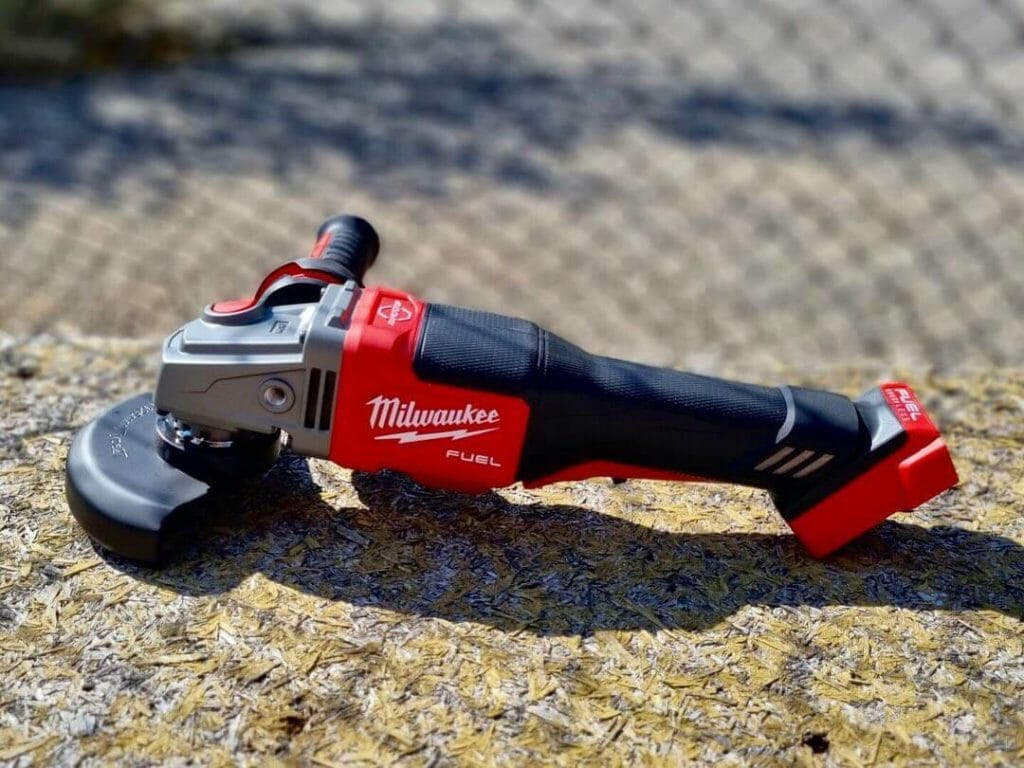
What Are 5 Common Metal Cutting Tools?
When needing to cut metals of different types, the choice of tool required depends pretty much on the job at hand. Ferrous metals are generally harder than non-ferrous metals and are also generally physically larger than, for example, an aluminum trim or copper pipe.
The most popular and practical metal cutting tools used in most professional and DIY enthusiast’s workshops:
- Angle Grinder
- Chop Saw
- Circular Saw
- Reciprocating Saw
- Jigsaw
Electric Metal Cutting Tools
Angle Grinder
A cordless 4-1/2″ angle grinder is one of the more popular options for cutting sheet metal, carbon steel tubing, round bar, non-ferrous metals such as aluminum and PVC, and hard plastics.
When fitted with a grinding disk, this grinder is helpful for the removal of burrs, shaping of metal by grinding away unwanted areas or even just removing rust from a metal surface.
The portability of the grinder, being battery operated, facilitates use in hard-to-reach areas. If you’re considering adding one to your tool chest, the DeWalt DCG413B is a brilliant entry-level grinder that comes to mind.
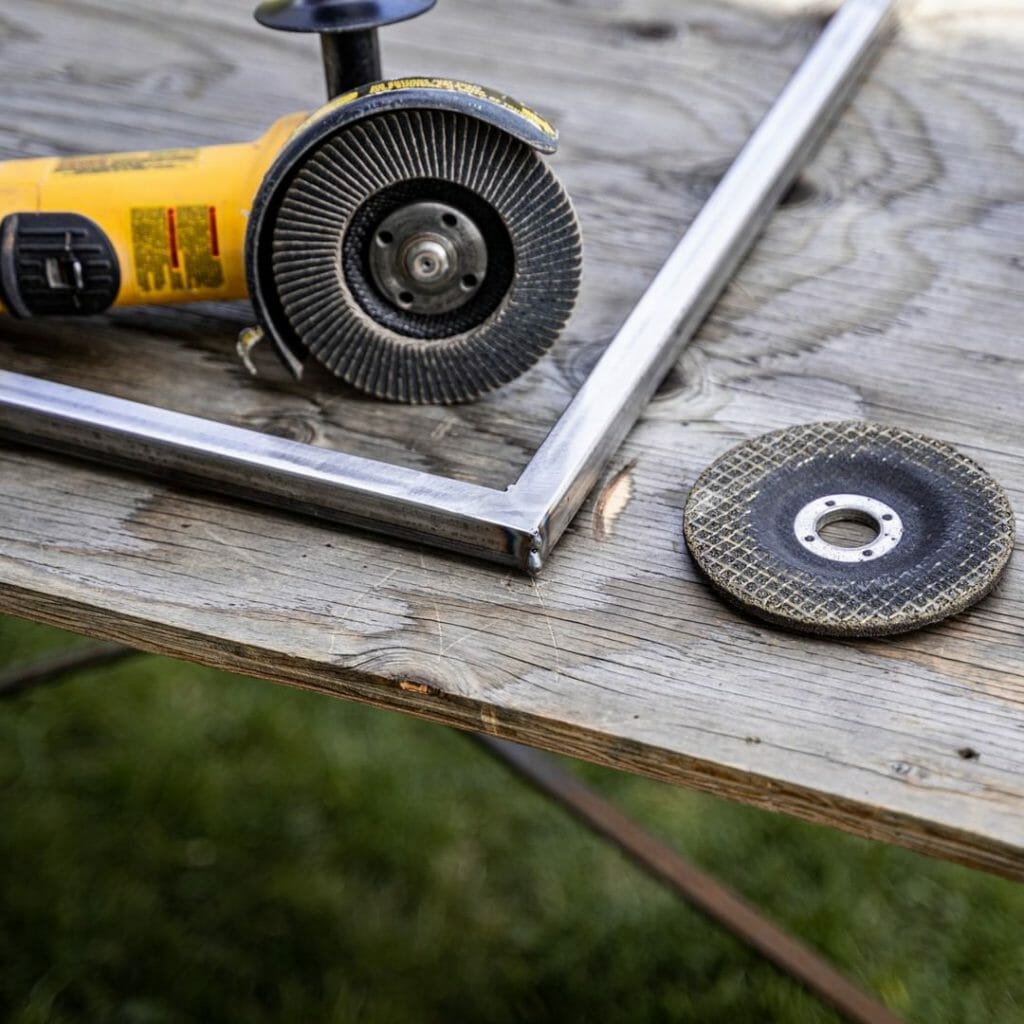
Chop Saw
Chop saws are great for cutting lengths of metal tubing or pipe to size. The chop saw makes precise cuts safely and efficiently without sparks and metal filings flying around when fitted with a metal cutting blade instead of an abrasive cutting wheel.
Having a metal cutting saw (like the Makita LC1230) at your disposal is great for those looking to cut metal tubing at ninety-degree or requiring beveled cuts. Fitted with a tungsten carbide blade as this saw is, it makes for a clean, virtually burr-free cut in all common metals.
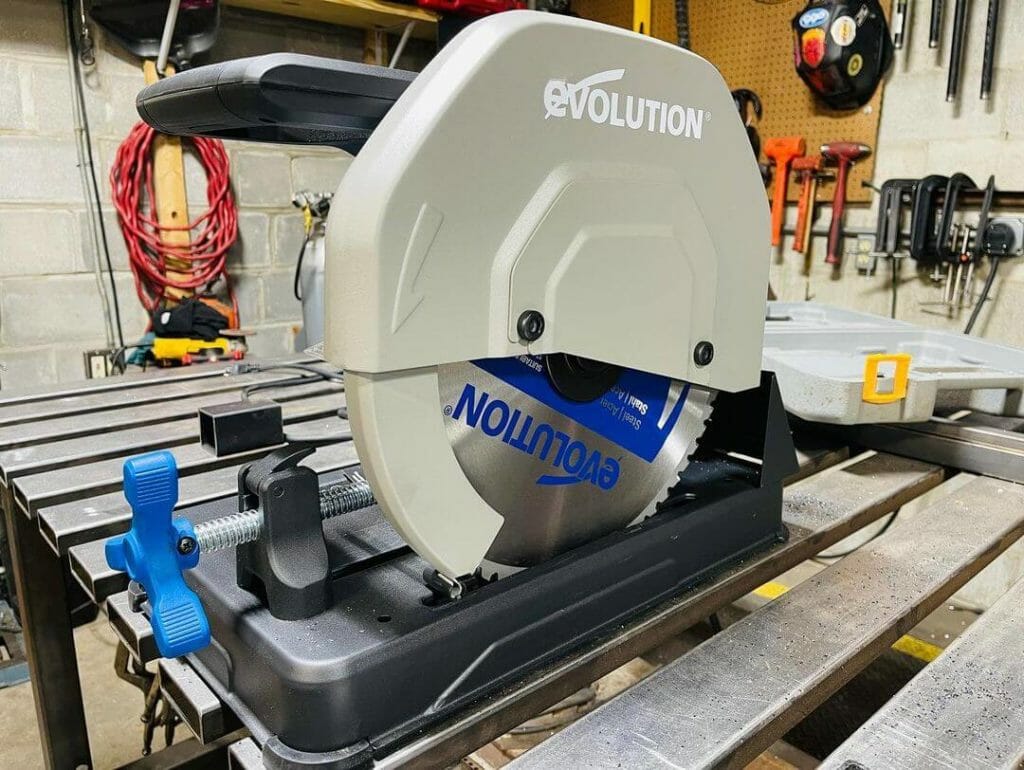
Circular Saw
Circular saws were initially made to cut straight cuts in wooden boards. Today’s blade technology has turned the wood-cutting circular saw into a very capable metal sheeting cutting saw when fitted with a tungsten carbide blade.
One renowned metal cutting circular is the Milwaukee Metal Cutting Circular Saw. The saw comes fitted with a 7-1/4″ tungsten tipped blade capable of cutting all common metals except for stainless steel, which requires a stainless steel cutting blade.
The Evolution saw is capable of beveled cuts up to forty-five-degree angles. This type of saw does its best work when performing straight-lined cuts in metal sheeting and performs well when cutting square tubes, piping, and metal rods.
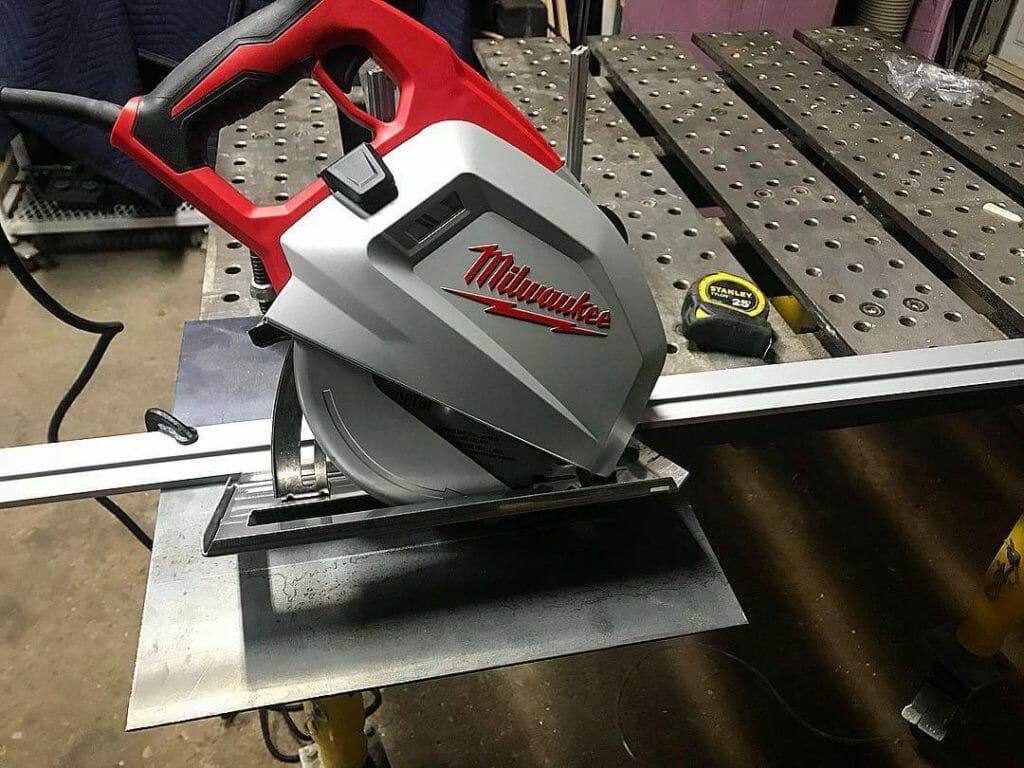
Reciprocating Saw
Reciprocating saws lend themselves very well to cutting metals that require correct sizing and work well in hard-to-reach areas, such as trimming overhangs or cutting an old pipe flush with the wall.
The Makita XRJ05T is an awesome saw that comes to mind and is powerful enough for cutting rebar, metal sheeting, round and square tubing, and non-ferrous metals such as copper tubing, brass, or aluminum.
Reciprocating saws have many uses. The cordless option opens the field of service even more. Different blade options are available for most if not all DIY projects and even include blades for cutting wood.
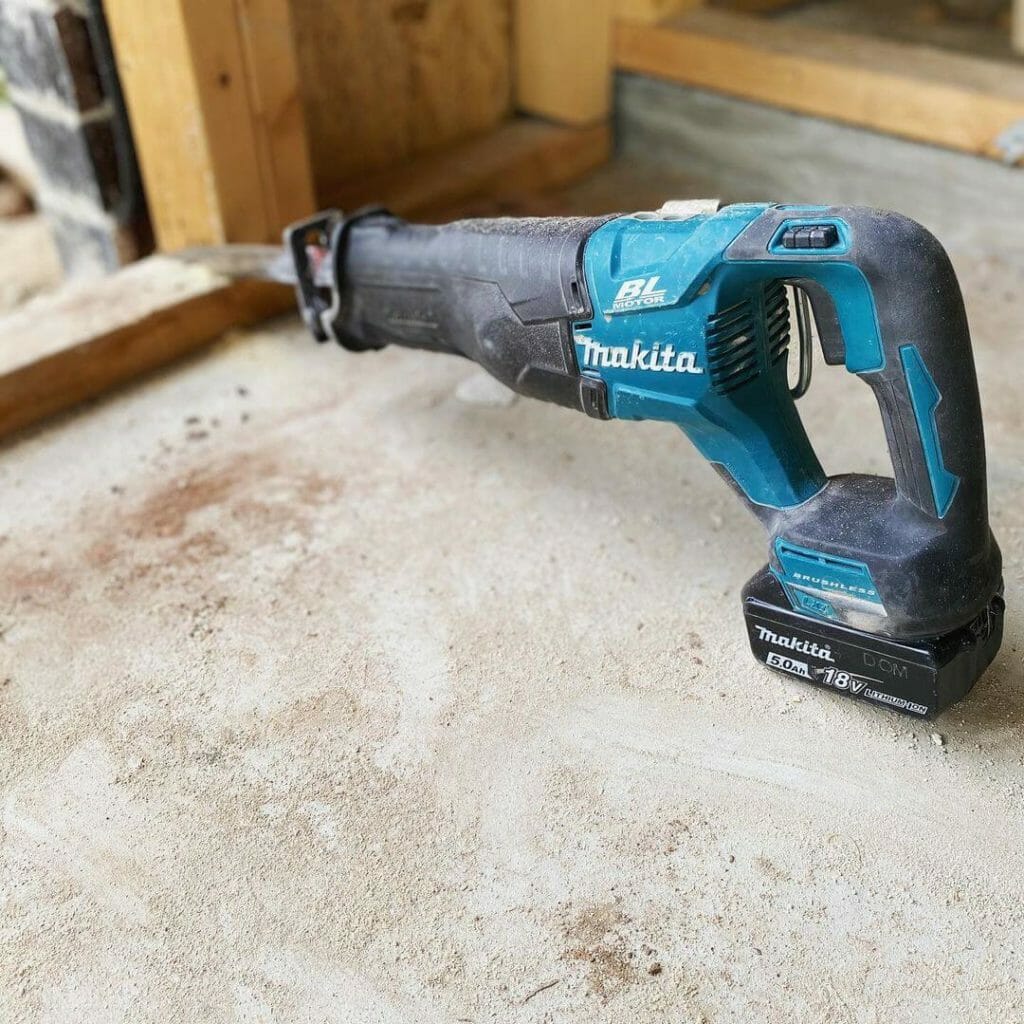
Jigsaw
Jigsaws have been around for years and have proven an indispensable tool in most workshops. Ideally, you’ll want to purchase a jigsaw (like the DeWalt DCS334B) that has a keyless blade locking system, making swapping out blades to cut various materials simple and easy.
Another recommendation would be to go cordless when shopping for a new jigsaw. The introduction of cordless or battery-operated tools significantly improves the power tool’s functionality and practicality.
Jigsaws can cut straight cuts with a guide, perform curved or circular cuts, cut flat boards and metal sheeting, and tubing of various types, including metals. All that’s needed is to choose the correct blade for the application.
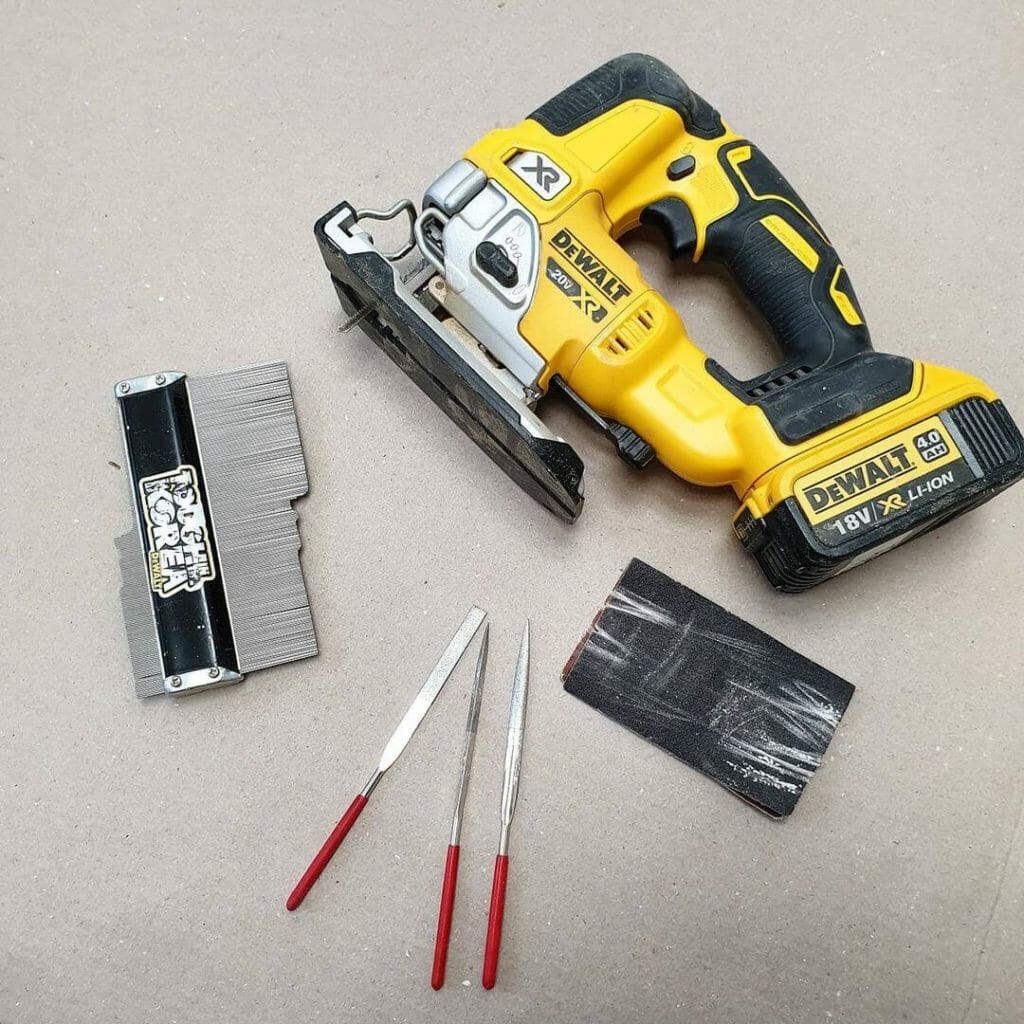
How To Choose The Right Blade For The Right Material?
Choosing the right blade for the materials you want to cut is vitally important to ensure your tool or your workpiece isn’t damaged. Your safety is also paramount, and you also don’t want to damage your tool by using the wrong blade.
Four primary material cutting blades are available with power tools: the Hacksaw type blade found on reciprocating saws, abrasive cutting wheel, carbide-tipped metal blades, and diamond-tipped blades.
Abrasive cutting discs or wheels are used in angle grinders and chop saws, while Carbide metal blades are used in chop saws and circular saws.
Diamond-tipped blades also fall into the abrasive cutting wheel category but cut cleaner and with less heat being generated. They’re well suited for use in angle grinders and chop saws.
Below is a summary of the materials that can be cut with the three circular-shaped blades:
| Abrasive Cutting Wheel | Carbide Metal Cutting Blade | Diamond Tipped Metal Cutting Blade |
|---|---|---|
| Nickel alloy | Non Ferrous metals | Steel Sheet |
| Carbon Steel | Carbon Steel | Carbon steel |
| Mild Steel | Mild Steel | Mild steel |
| Stainless Steel | Steel Pipe | Non Ferrous metals |
| Steel Pipe | PVC Pipe | PVC Pipe |
| PVC Pipe | Stainless steel sheet | Hard Plastics |
| Tin | Hard Plastics | |
| Aluminum | Steel sheet | |
| Inconel | Hard Plastics | |
| Wood |
What Is The Best Material Cutting Blade?
The carbide-tipped blade is the best for cutting various materials, including stainless steel sheets.
Carbide blades are only suited to use with circular saws and chop saws for best results. Carbide blades are available in different sizes, rotation ratings, teeth per inch, and tooth configurations.
The configuration of the blade’s teeth significantly influences the quality of the cut in any given material, the heat generated during the cut, and the power required to cut effectively.
Blades are generally well labeled, so take note of the specific uses for the blade before buying. The blade rotation speed is also important to note to match the speed of your saw.
Which Hand Tool Is Used For Cutting Metals?
Hand tools to cut metals are numerous and have many applications depending on the job.
Most DIY enthusiasts probably have a pair of tin snips, a hacksaw, and maybe even a bolt cutter in their arsenal of hand tools. Some like me may even have variations of the same tool that probably gets the job done in the same way but has their unique appeal.
Hand-Held Metal Cutting Tools
Hacksaw
Hacksaws have been around for a very long time. Hacksaws are made for cross-cutting ferrous and non-ferrous metals using good old manual labor.
Dewalt has an excellent product in the form of their 5-in-1 hacksaw, which is a magnificent design feat and about as innovative as one can be when it comes to hacksaw design. They deserve a medal for this one.
Using the correct blade is always the key when cutting metals or any material. Most hacksaw blades cut ferrous metals such as carbon steel and cast iron, while non-ferrous metals are metals such as aluminum, copper, and brass. Rigid plastics and PVC are also easily cut using a hacksaw.
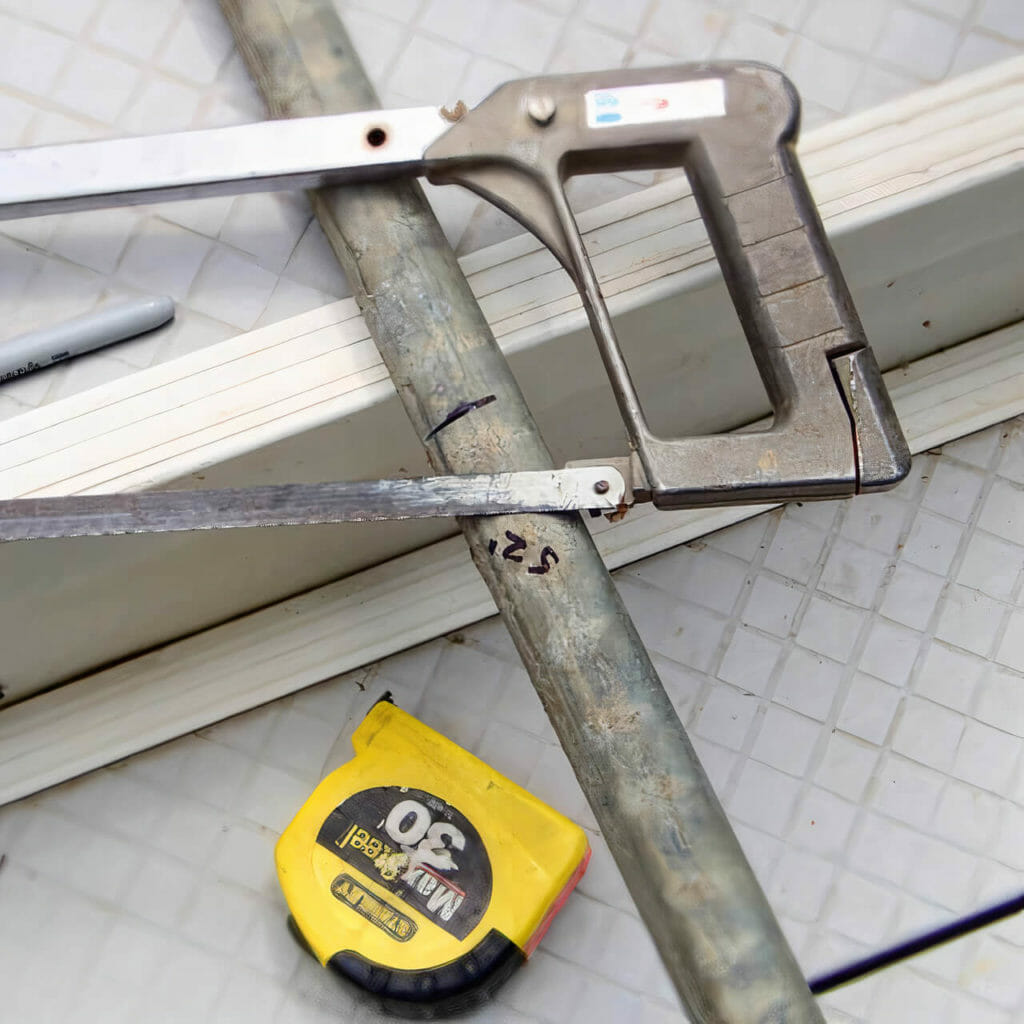
Tin Snips
As the name suggests, Tin snips are made to cut sheet metals of various types. Tin and galvanized steel sheeting used to make roof sheeting are the most commonly cut steel sheets using tin snips.
Midwest aviation snip sets are a great example of such snips. The offset design of the MWT65-10C tin cutting offset left and right cut metal shears lends itself well to the making of straight cuts due to the metal sheet passing below the handles of the shears.
Tight left and right-angled cuts are also easy to achieve with the drop forged, all-American manufactured blades. The KUSH’N-POWER comfort grips ensure the user exerts minimal pressure onto the handles to get the job done.
Tin snips are well suited for intricate cutting of sheet metals, whereas other metal saws are not.
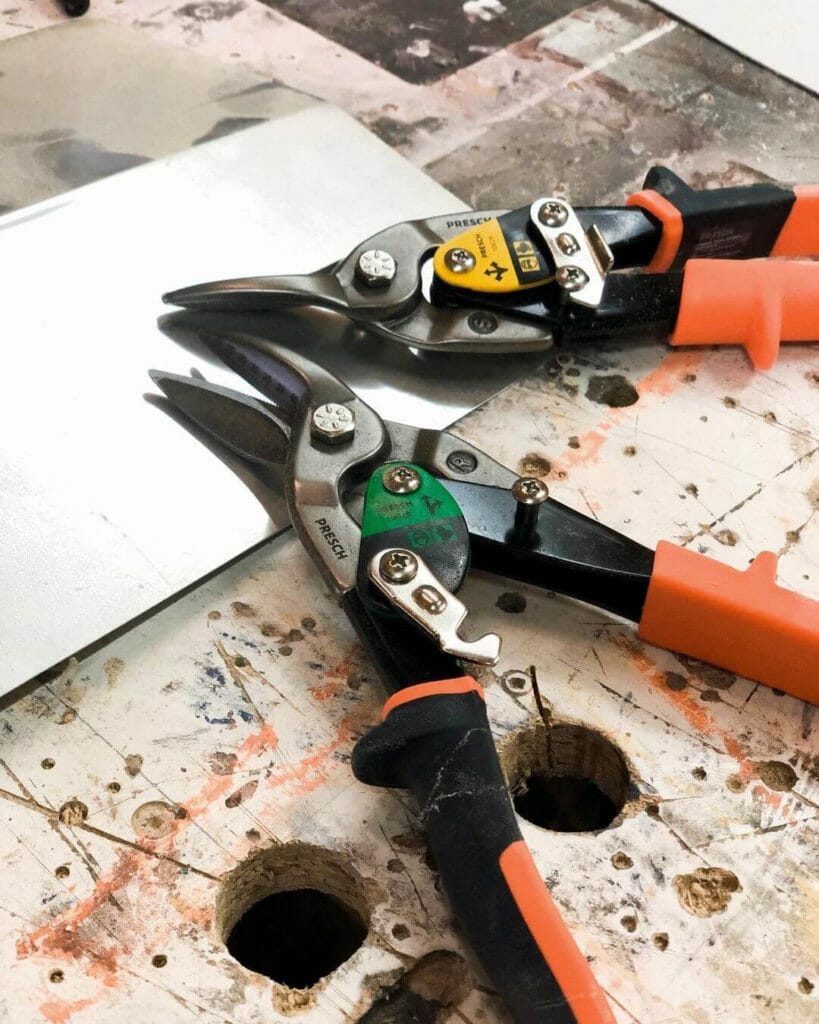
Bolt Cutters
Bolt cutters are convenient tools that every DIY enthusiast should have in their arsenal of tools.
The cutters range in size from ones barely larger than a pair of pliers to giant bolt cutters, three to four feet in length, meant for serious metal cutting tasks.
Bolt cutters are often only seen as tools used to cut chains or padlocks. They do work well for these applications, but more bolt cutters are used daily to cut steel rods and rebar to size than any other use.
Our choice for around the home is the Wilfiks 12″ Bolt Cutter. The heavy-duty chrome alloy jaws are perfect for cutting chain locks, wire mesh, padlocks, rods, screws, baling wire, electrical wire, and cable. The bi-materials used to manufacture the handles ensure a comfortable, ergonomic, soft rubber grip.
A nice feature built into the cutters is the shock absorption stoppers that, together with the soft handles, prevent shock from being transferred to your hands or wrists during the cutting process.

Tips For Cutting Metal Safely
Due to metal being hard and thus requiring powerful machines to cut, the process can be dangerous.
Most accidents occur due to the material moving out of alignment when the blade starts cutting. Movement can cause the blade to jam, splinter, or kick the material being cut out of the saw. Materials that are not securely secured and supported along the entire length can move.
Powerful saws such as chop saws, angle grinders, and circular saws use blades that endure significant stresses during the cutting process. Pinching of the blade can quickly happen during the cutting process, especially when the blade is making a deep cut. Securely clamping the workpiece on both sides of the blade will prevent this.
Take it slow, and don’t force the blade excessively onto the workpiece. Blades are designed to shave away material little by little. Placing excessive force on the blade may cause it to bite into the material and jam, which can have disastrous consequences.
Take heed of your environment and make sure passersby and pets are safe in your work area. No flammable materials should be anywhere near where you’re cutting metal.
Make Sure You Wear Appropriate Safety Equipment
Most metal cutting tools generate metal shavings, sparks, noise, and heat, so wearing safety equipment is vital.
Essential safety equipment required to keep you safe when cutting metal:
How To Cut Metal Without Sparks?
Most of us will be well aware of the noise and sparks generated during the metal cutting process. The sparks are a product of the heat generated between the blade and steel while cutting using an abrasive cutting wheel.
Saws such as angle grinders and chip saws are synonymous with a shower of sparks which makes using them downright uncomfortable and dangerous. Ferrous metals containing iron are most prone to generating sparks during the cutting process.
The advent of carbide-tipped blades has revolutionized the cutting of ferrous metals. The blade tips efficiently cut while generating minimal metal sparks, virtually do away with burrs and keep the heat down to safe levels while cutting. These blades are well suited for use in chop and circular saws.
Use A No Spark Cutting Disk
The 4.5″ Black Gaff cut-off diamond cutting wheel uses new high-temperature plasma soldering to attach the synthetic diamond grit to the blade.
As such, the blade produces significantly fewer sparks during the cutting process.
The blades are well suited for cutting ferrous and non-ferrous metals and are suitable for 3000 cuts.
The Bottom Line
There are heaps of metal cutting tool options available. Modern steel disks have mostly replaced the old-generation abrasive cutting disks, meaning that the old shower of sparks when cutting steel is all but gone.
Key Takeaways:
Today’s most popular metal cutting tools are the Hacksaw, Tin snips, Bolt Cutters, Angle Grinder, Chop saw, Jigsaw, Reciprocating saw, and Circular saw. The right tool for the job depends mainly on the type of metal you need to cut.

